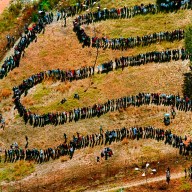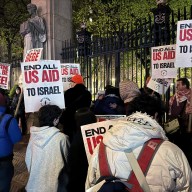 Flowers lie on the sidewalk at the site of the first explosion as people walk along Boylston Street after the street reopened to the public for the first time since the Boston Marathon bombings in April 2013. Credit: Reuters
Flowers lie on the sidewalk at the site of the first explosion as people walk along Boylston Street after the street reopened to the public for the first time since the Boston Marathon bombings in April 2013. Credit: Reuters
A new report released Thursday by Harvard University examines the response to the Boston Marathon bombings and said that the efforts by officials to prepare and ready for catastrophe helped execute a fast response following the blasts.
Much of the success, the authors wrote, was “the result of extensive and careful planning, years of investmentsand training, structure, skill- and relationship- and trust-building.”
The report, titled “Why Was Boston Strong? Lessons from the Boston Marathon Bombing,” was co-authored by four scholars of emergency management and criminal justice at Harvard Kennedy School, Law School and Business School, Harvard said. It analyzed the 100 hours between the moment the first bomb exploded on April 15 through the arrest of accused bomber Dzhokhar Tsarnaev.
The report cites an effective on-scene triage, the rapid mobilization of area hospital emergency departments and the quick response by survivors, bystanders and professional responders at the scene as why the bombings resulted in a far lower causality count than would have been expected.
Additionally, law enforcement’s ability to quickly respond and secure the blast area, establish a central coordination and command and organize investigative work were some of the successes of that day.
“Our research suggests that major contributing factors to much of what went well – and to some of went less well – were the command and coordination structures, relationships, and circumstances through which responding organizations were deployed and managed,” the report says.
The report includes recommendations for agencies charged with preparing and responding to planned and unforeseen crises. They include: quickly establishing a cross-agency, senior strategic and policy-making level of engagement and secure command post; develop a more effective process to manage the inevitable self-deployment of responders who arrive at events as independent individuals rather than in organized units; and review current training and practice on control of weapons fire.
The authors hope the observations and analysis can provide future guidance for other large-scale events.
“We believe that many of the lessons about mastering highly uncertain and fluid events will apply to many other event scenarios just as well — natural disasters and industrial accidents, for example, in addition to terror-related events,” the report said.
Follow Michael Naughton on Twitter @metrobosmike.
















